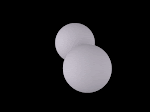IC 418 - The Spirograph Nebula
is a bright planetary nebula of approximately 0.3 light-year across, located in the Milky Way Galaxy, some 2,000 light-years away in the constellation of Lepus. The nebula is moving away from us at about 62 kilometers per second.
The name derives from the strange, not well understood, texture of the nebula which resembles a pattern which can be created using the Spirograph, a toy which produces geometric patterns on paper.
Despite their name, planetary nebulae have nothing to do with planets. The name of planetary nebulae arose because of the visual similarity between some round planetary nebulae and the planets Uranus and Neptune when viewed through early telescopes.
A planetary nebula represents the final stage in the evolution of a star similar to our Sun. Only a few thousand years ago, the star at the center of the Spirograph Nebula was a red giant, but then ejected its outer layers into space to form this expanding nebula. The stellar remnant at the center is the hot core of the red giant. Over the next several thousand years, the nebula will gradually disperse into space, and then the star will cool and fade away for billions of years as a white dwarf. Our own Sun is expected to undergo a similar fate, but fortunately this will not occur until some 5 billion years from now.
Glowing like a multi-faceted jewel, the nebula’s luminosity is around 1500 times that of the Sun. The small, slightly elongated nebula consist of a filigree pattern and an inner ring. The star is off-center within the inner ring. The outer ring is subtly bi-polar, rather reminiscent of the Ring Nebula in Lyra, perhaps showing us what the Ring used to look like.
The patterns of the Spirograph are perhaps related to chaotic winds from the variable central star, which changes brightness unpredictably in just a few hours. The light from the central core excites surrounding atoms in the nebula causing them to glow. Still, the temperature of the central star is only about 35,000 K, what makes the star so “cool” that only about 75 percent of the nebular helium is ionized.
The small size of the nebula is consistent with the low star temperature of early evolution, as the star is still heating and the nebula growing, albeit at a low expansion rate of 12 kilometers per second.
This image was obtained with the Hubble Space Telescope. It is shown in a false-color representation, based on Wide Field Planetary Camera 2 exposures taken in February and September, 1999 through filters that isolate light from various chemical elements. Red shows emission from ionized nitrogen (the coolest gas in the nebula, located furthest from the hot nucleus), green shows emission from hydrogen, and blue traces the emission from ionized oxygen (the hottest gas, closest to the central star).
 |
| The Spirograph Nebula |







0 comments:
Post a Comment